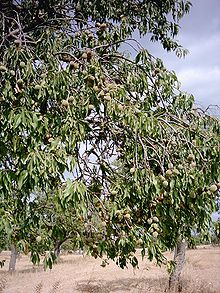**Botanical Characteristics and Taxonomy:**
– Almond is a deciduous tree belonging to the genus Prunus.
– The almond fruit is a drupe, not a true nut, with a hard shell surrounding the edible seed.
– Almond trees start bearing fruit in the third year after planting.
– Almonds have white to pale pink flowers and leaves with serrated margins.
– The almond tree thrives in Mediterranean climates with specific temperature and moisture requirements.
**Cultivation and Distribution:**
– Almonds were among the earliest domesticated fruit trees, dating back to the Early Bronze Age.
– Almond cultivation spread from Iran to regions along the Mediterranean and Europe.
– California, USA, is a significant region for almond cultivation.
– Wild forms of domesticated almonds can be found in parts of the Levant.
– Different almond varieties, like Nonpareil and Tuono, are cultivated for specific traits.
**Breeding and Pollination:**
– Breeding programs have identified traits like the high shell-seal trait for almonds.
– Almond trees are mostly self-incompatible and require cross-pollination for good nut production.
– California’s almond pollination event is the largest managed pollination globally.
– Self-pollinating almond trees with commercial quality nuts have been developed.
– Pollination brokers manage the supply of bees for almond pollination.
**Health and Nutrition:**
– Almonds are nutritionally dense, providing essential vitamins, minerals, and healthy fats.
– Regular almond consumption may reduce the risk of heart disease by lowering LDL cholesterol levels.
– Almonds are recognized as a good protein source and a healthy snack option.
– Almonds are rich in phytosterols like beta-sitosterol, contributing to their nutritional value.
– Various studies support the positive impact of almonds on heart health and overall nutrition.
**Culinary Uses and Products:**
– Almonds are used in various cuisines worldwide, from French dacquoise to Indian pasanda-style curries.
– Almond milk, butter, and oil serve as versatile dairy substitutes in cooking and baking.
– Almond flour is a gluten-free alternative, while almond skins are used in dietary supplements.
– Almond oil, rich in monounsaturated and linoleic acid, is used in aromatherapy and cosmetics.
– Bitter almonds are sold cautiously due to cyanide content, while sweet almonds are widely used in culinary applications.
The almond (Prunus amygdalus, syn. Prunus dulcis) is a species of small tree from the genus Prunus, cultivated worldwide for its seed, a culinary nut. Along with the peach, it is classified in the subgenus Amygdalus, distinguished from the other subgenera by corrugations on the shell (endocarp) surrounding the seed.
| Almond | |
|---|---|

| |
| 1897 illustration | |

| |
| Almond tree with ripening nuts. | |
| Scientific classification | |
| Kingdom: | Plantae |
| Clade: | Tracheophytes |
| Clade: | Angiosperms |
| Clade: | Eudicots |
| Clade: | Rosids |
| Order: | Rosales |
| Family: | Rosaceae |
| Genus: | Prunus |
| Subgenus: | Prunus subg. Amygdalus |
| Species: | P. amygdalus
|
| Binomial name | |
| Prunus amygdalus Batsch, 1801
| |
| Synonyms | |
|
Replaced syn.
Homotypic
Heterotypic
| |
The fruit of the almond is a drupe, consisting of an outer hull and a hard shell with the seed, which is not a true nut. Shelling almonds refers to removing the shell to reveal the seed. Almonds are sold shelled or unshelled. Blanched almonds are shelled almonds that have been treated with hot water to soften the seedcoat, which is then removed to reveal the white embryo. Once almonds are cleaned and processed, they can be stored over time. Almonds are used in many cuisines, often featuring prominently in desserts, such as marzipan.
The almond tree prospers in a moderate Mediterranean climate with cool winter weather. Native to Iran and surrounding countries including the Levant, today it is rarely found wild in its original setting. Almonds were one of the earliest domesticated fruit trees, due to the ability to produce quality offspring entirely from seed, without using suckers and cuttings. Evidence of domesticated almonds in the Early Bronze Age has been found in the archeological sites of the Middle East, and subsequently across the Mediterranean region and similar arid climates with cool winters.
California produces over half of the world's almond supply. Due to high acreage and water demand for almond cultivation, and need for pesticides, California almond production may be unsustainable, especially during the persistent drought and heat from climate change in the 21st century. Droughts in California have caused some producers to leave the industry, leading to lower supply and increased prices.
